The Brazos Review: AMD's E-350 Supplants ION for mini-ITX
by Anand Lal Shimpi on January 27, 2011 6:08 PM ESTDiscrete GPUs on Brazos: CPU and PCIe Bound
Intel's Atom could use a more capable GPU, but what about Brazos? The E-350's GPU is branded the AMD Radeon HD 6310. It has a total of 80 VLIW-5 SPs running at 500MHz. The GPU shares the same 64-bit DDR3 memory interface as the CPU, but it does not have any access to the CPU's caches. Future incarnations of Fusion will blur the line between the CPU and GPU but for now, this is the division.
Branching off the E-350 APU are four PCIe lanes. There are another four lanes courtesy of the Hudson FCH. MSI's E350IA-E45 exposes the former by the way of a physical PCIe x16 slot, although electrically it's only a x4. Curious to see if there would be any benefit to plugging in a faster GPU I decided to try a Radeon HD 5450 and 5570 in the slot:
With a couple of exceptions (World of Warcraft, HAWX), there's no real benefit to a discrete Radeon HD 5450 over the integrated Radeon HD 6310. This is unsurprising as the two have very similar compute capabilities and only differ in the amount of available memory bandwidth since the Radeon HD 5450 doesn't have to share with a neighboring CPU.
The Radeon HD 5570 results were a bit unexpected. Other than Modern Warfare 2 and BioShock 2, there's little performance difference between the 5570 and the 5450 when paired with the AMD E-350. How much of this is due to the performance of the E-350 vs. the bandwidth limitations of the PCIe x4 slot is difficult to say. This smells like a CPU limitation, in which case it would mean that AMD didn't skimp at all when it came to the E-350's GPU.
The Radeon HD 6310: Very Good for the Money
I want to say that lately we've seen a resurgence in the importance of integrated graphics, but I don't know that it ever was truly important. With both AMD and Intel now taking processor graphics seriously, the quality and performance of what we get "for free" should go up tremendously in the coming years. The past two years have shown us that Intel is starting to take GPU performance seriously. The HD Graphics, HD Graphics 2000 and 3000 parts we've been given are all relatively competitive. The only problem is you generally have to spend around $100 - $200 on a CPU to get what I'd consider the bare minimum you should get from integrated graphics. Brazos aims to change that.
The E-350 still isn't enough to play all modern games, but it's what I would consider an acceptable entry level GPU. Despite its stature, the E-350 can easily compete with much more expensive Intel solutions when it comes to 3D gaming. Let's get to the numbers.
Dragon Age: Origins
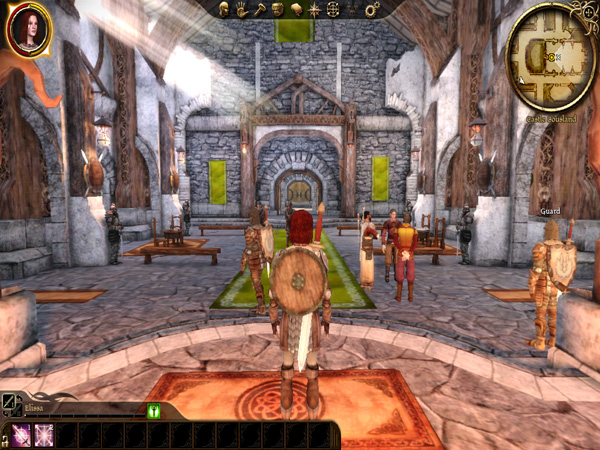
DAO has been a staple of our integrated graphics benchmark for some time now. The third/first person RPG is well threaded and is influenced both by CPU and GPU performance.
We ran at 1024 x 768 with graphics and texture quality both set to low. Our benchmark is a FRAPS runthrough of our character through a castle.
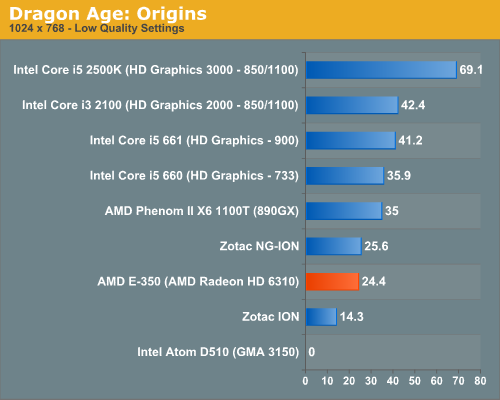
Our Dragon Age: Origins benchmark is quite CPU bound here and thus the E-350's Radeon HD 6310 doesn't look all that powerful. Luckily for AMD, DAO happens to be more of an outlier among current games as you're about to see.
The bare bones Atom D510 won't even run DAO. You'll see a number of games where compatibility is a problem for the D510. NVIDIA's ION does a lot better but it'll take a second generation ION to hang with the E-350. Zotac's NG-ION is actually a bit faster than the E-350, implying some driver/threading efficiencies as we're most definitely CPU bound on these low end parts.
Dawn of War II

Dawn of War II is an RTS title that ships with a built in performance test. I ran at the lowest quality settings at 1024 x 768.
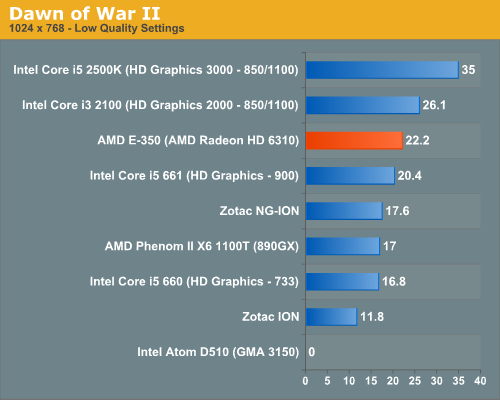
Oh what a difference moving a bottleneck makes. The AMD E-350, with its 75mm2 die is faster than Intel's Core i5 661 - the fastest implementation of Intel's HD Graphics. The E-350's performance isn't too far off the Core i3 2100 either. While none of these frame rates are what I'd call smooth, you can't argue with how competitive the E-350 is here.
Call of Duty: Modern Warfare 2

Our Modern Warfare 2 benchmark is a quick FRAPS run through a multiplayer map. All settings were turned down/off and we ran at 1024 x 768.
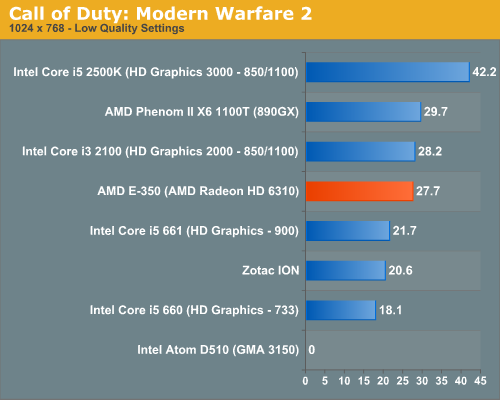
Modern Warfare 2 paints an even better picture for AMD. The E-350 offers virtually the same performance as Intel's Core i3 2100, and noticeably better performance than the Core i5 661. Need I mention that you get this at a much lower price than either of the aforementioned CPUs?
BioShock 2
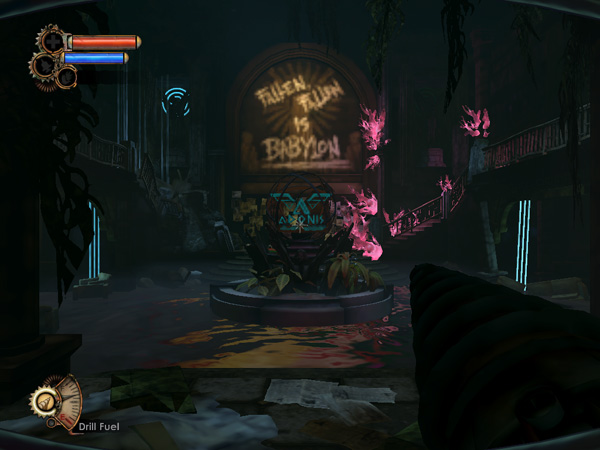
Our test is a quick FRAPS runthrough in the first level of BioShock 2. All image quality settings are set to low, resolution is at 1024 x 768.

Again the E-350 continues to hang with the best here. The frame rates are still not high enough to get excited, but the effort is top notch.
World of Warcraft
Our WoW test is run at fair quality settings (with weather turned down all the way) on a lightly populated server in an area where no other players are present to produce repeatable results. We ran at 1024 x 768.
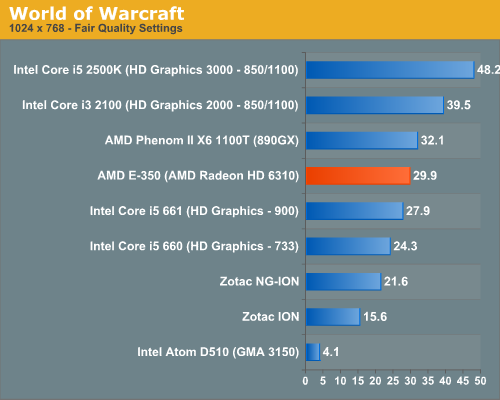
AMD's E-350 is faster than anything from the Clarkdale era, while just a bit slower than AMD's 890GX. Intel's HD Graphics 2000 is faster but at a much higher power consumption and pricetag of course. Intel's Atom D510 can complete our benchmark here but at a laughable 4.1 fps. Both the first and second generation ION platforms fall behind Brazos.
HAWX
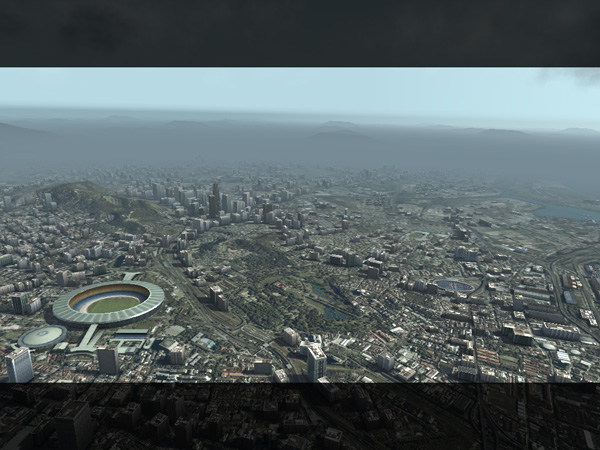
Our HAWX performance tests were run with the game's built in benchmark in DX10 mode. All detail settings were turned down/off and we ran at 1024 x 768.
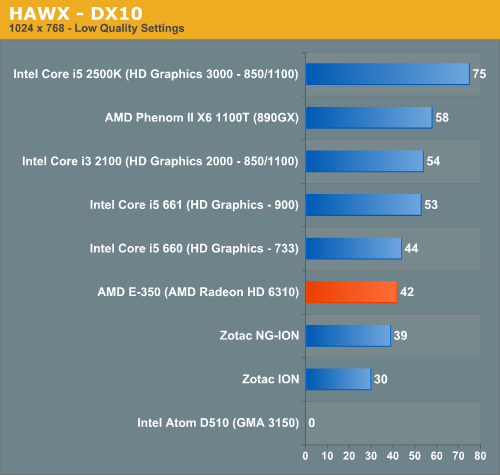
With HAWX CPU performance matters a bit more, pushing the E-350 just slightly behind the Core i5 660. The Radeon HD 6310 still delivers respectable performance in HAWX, especially considering its price point. The next-generation ION does come close in performance to the E-350, while the original ION is significantly slower.
Starcraft II

We have two Starcraft II benchmarks: a GPU and a CPU test. The GPU test is mostly a navigate-around-the-map test, as scrolling and panning around tends to be the most GPU bound in the game. Our CPU test involves a massive battle of 6 armies in the center of the map, stressing the CPU more than the GPU. At these low quality settings however, both benchmarks are influenced by CPU and GPU.
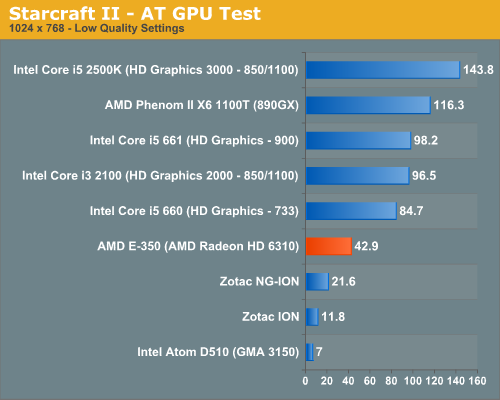
In our GPU specific test, the E-350 is significantly faster than anything Atom based. While the D510 can technically run this test, it does so at only 7 fps. Even the next-generation ION only manages 21.6 fps. The E-350 with its Radeon HD 6310 delivers nearly twice the frame rate of the fastest ION. The advantage isn't purely on the GPU side. As I mentioned before, Starcraft II can be very CPU bound at times. The Bobcat cores at work in the E-350 help give it a significant advantage over anything paired with Atom.
The CPU dependency is what separates the E-350 from its larger, more expensive competitors here. The gap only widens as we look at what happens in a big battle:
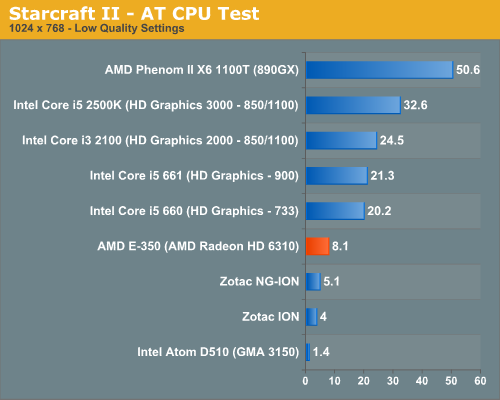
While you can play Starcraft II on any of these systems, to maintain frame rate throughout all scenarios you really need more CPU and GPU horsepower.
Call of Duty: Black Ops
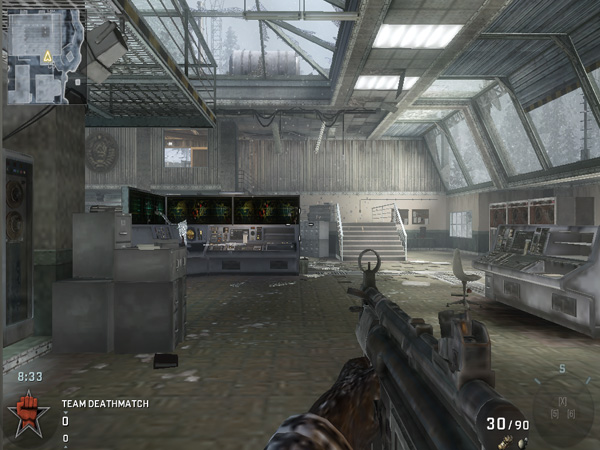
Our Black Ops test is a quick FRAPS runthrough on a private multiplayer server. The game was set to 1024 x 768 at the lowest quality settings.
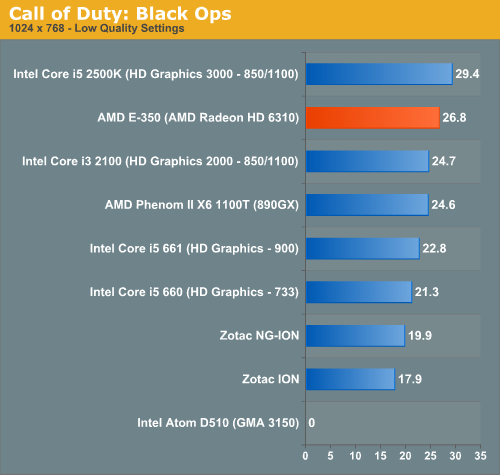
In Black Ops the E-350 does the best it has done thus far, nearly equaling the performance of Intel's HD Graphics 3000. In our Sandy Bridge Review I wondered if Intel was being limited by driver issues here as there's very little difference between the 3000 and 2000 GPUs. The E-350 benefits from all of the driver tweaks and experience AMD has from the Radeon side so it immediately puts its best foot forward. AMD's greatest ally in Fusion will be its driver experience.
Mafia II
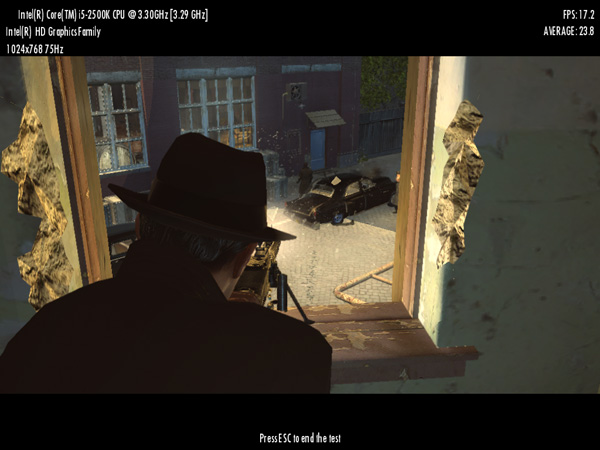
Mafia II ships with a built in benchmark which we used for our comparison:
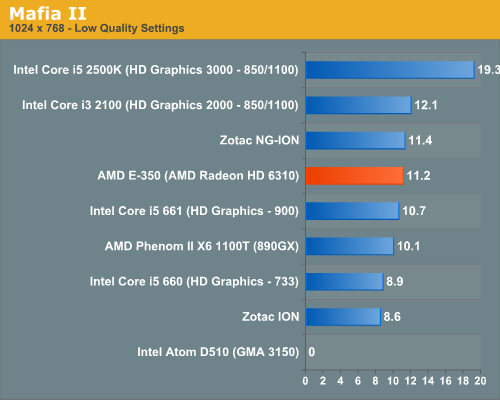
Mafia II doesn't run well on any integrated graphics platform, regardless of vendor. The E-350 does well vs. the competition but none of these platforms are playable, even at the lowest settings.
Civilization V
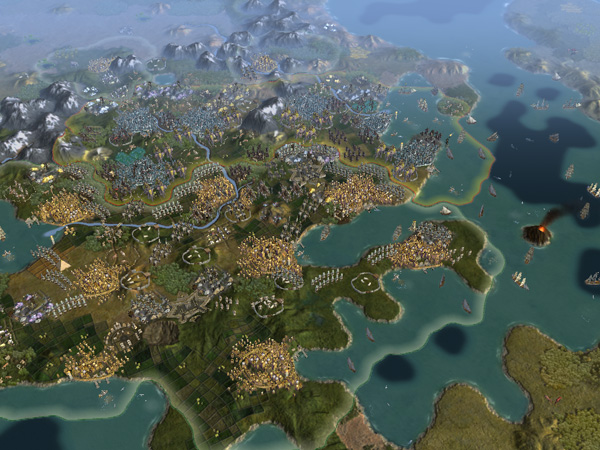
For our Civilization V test we're using the game's built in lateGameView benchmark. The test was run in DX9 mode with everything turned down at 1024 x 768:
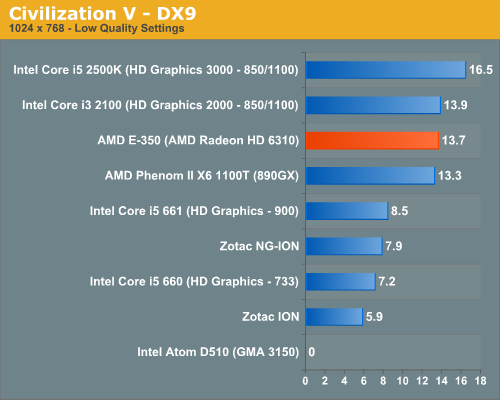
Civilization V doesn't run well on any integrated graphics platform, but the E-350 runs it at least as well (or as poorly?) as Intel's Core i3 2100. The Bobcat cores help with a lot of the heavy lifting here giving the E-350 a substantial lead over Atom.
Metro 2033
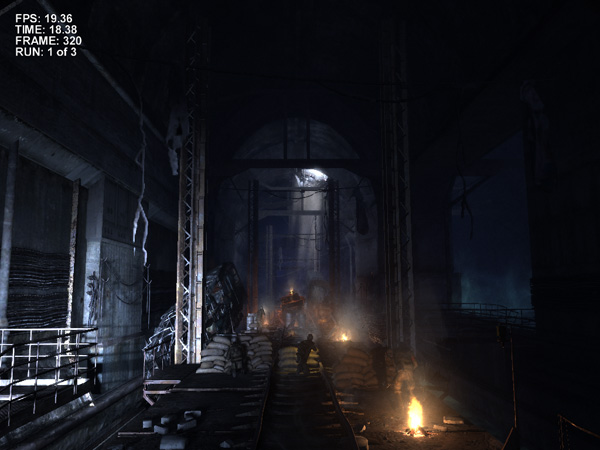
We're using the Metro 2033 benchmark that ships with the game.
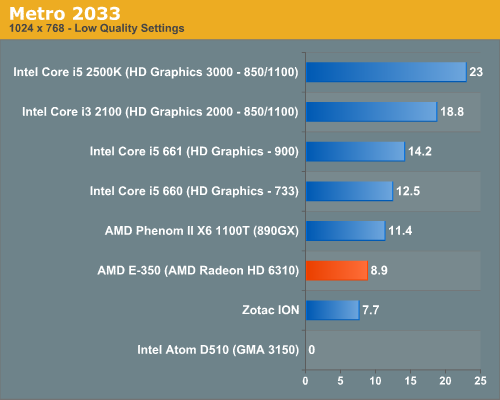
Metro 2033 is a bit too modern for these low end platforms. The E-350 is faster than ION but not in the realm of playability.
DiRT 2
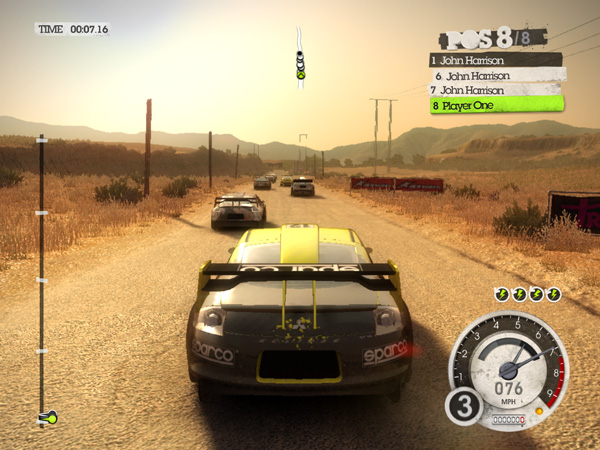
Our DiRT 2 performance numbers come from the demo's built-in benchmark:
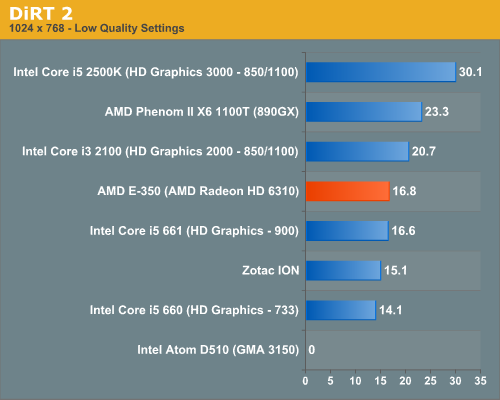


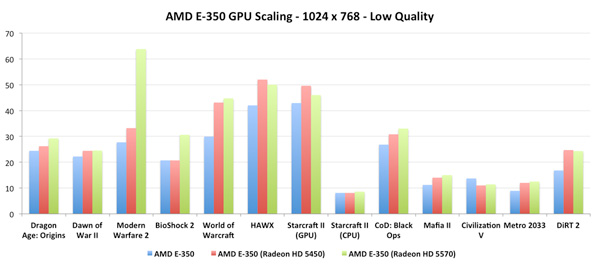








176 Comments
View All Comments
Matt310 - Friday, January 28, 2011 - link
At home in my desktop machine I have a 4-lane PCI-x hardware RAID card with four 1.5TB drives configured in RAID 5 for speed hand fault tolerance. For a while now I've been wondering how the i/o performance of a good RAID card would fair if it was moved to a low-power (e.g. Atom- or Brazos-based) mini-ITX NAS system. I've been googling for a review of this setup but not been able to find anything conclusive.Think a lot of people would appreciate if you guys could give this a try and report on your findings!
Thanks Anand!
msroadkill612 - Friday, February 4, 2011 - link
Well you should know - dont the raid cards have their own smarts & put little work on the cpu?My guess is it would be a great unit for a dedicated server. In the old days, many dedicated servers kept their 486 pcS for a decade as they ran fine.
a post above linked to a comparison of running pciE graphics cards at 1,4,8,16 lanes, & the difference between 4 x &16 by was slight. I imagine its the same with raid cards.
jjcrandall - Friday, January 28, 2011 - link
Anand, I didn't see what hdd you used for the tests. It would be very interesting to see how this platform performed in some of the benchmarks with a ssd. I know pcmark & vantage productivity benches use hdd test's to a certain degree.This really shows either how poor netburst was as an architecture, or how good existing sub 10w designs are.
Shadowmaster625 - Friday, January 28, 2011 - link
It seems like the E-350 was built for overclocking. Especially on the desktop or with any cooling solution that has an extra 10 Watts of thermal headroom. Sooner or later someone is going to release a mini-ITX board that can OC an E-350 up to 2.5GHz and beyond. Right? It's not like the new intel cpu where you cannot overclock it, right?bjacobson - Saturday, January 29, 2011 - link
yeah I definitely want to overclock it!In a laptop when you've got an 8-10 hour battery life, if you know you're only going to need the laptop for 4 hours today, why not just crank up the speed? Great having that option.
Arnulf - Friday, January 28, 2011 - link
"Unfortunately in modern titles that's not always enough to have a playable experience, but with older games you should be able to do more with Brazos than you ever could with Atom or even ION for that matter. The CPU/GPU balance in the E-350 is good enough that I feel like Llano could make for a pretty decent value gaming machine."Given that Zacate/Brazos performs at the level of 5+ years old midrange desktop CPU with midrange GPU and considering the quoted statement above it would be very interesting to see some actual performance data taken in titles that Zacate/Brazos *can* run at bearable FPS rates.
You could look up your performance charts from 5 years ago, dig out the old titles and rerun the benchmarks with those titles on Zacate/Brazos. This should give people better idea what they can expect from this generation of APUs. Sub-20 FPS rates in modern titles at rather low resolution and with all details at minimum isn't exactly what people have their sights on when deciding whether to shell out money for their new toy. Comparison with other crappy graphics that is on par with 5 year old solutions may give AMD's platform some edge over competition from Intel's camp, but it utterly meaningless as nobody is planning to use it in such setting.
Myself, I'd *love* to see some factual data from titles such as CoD2, DiRT, Doom3, etc. - the games you were referring to in the paragraph quoted above and all of which you already have reference benchmarks of (in order to have something to compare Zacate/Brazos against, without having t rerun all the benchmarks with old software titles). Such a benchmark with usable performance and enough eye candy will help put Zacate/Brazos' use in gaming setting into perspective, very much unlike those ~20 FPS tests you did above.
These merely indicate that integrated graphics of today are still useless for gaming.
bjacobson - Saturday, January 29, 2011 - link
Hm that's a good point. Likely I'd be playing a copy of UT2k4, perhaps quake 3 online, or some older online RTS. How do these fare at those games?cjs150 - Friday, January 28, 2011 - link
Nice review.There is a passively cooled E-350 board coming out. The review convinces me that this will be the right choice for the HTPC for the main room.
Why: TV already connected to an AV receiver so an E-350 system can use the HDMI connection to the AV receiver. E350 more than powerful for BluRay, fine for some light web surfing, ripping music. Maybe stick a TV tuner in as well and that is the main room sorted.
I have no intention of playing modern games on it so lack of power is not a problem. I have a bigger PC in study to rip movies if it takes too long on the E350.
But I also have an Atom based system. Again passively cooled. I use it as a server for the home network. It works just fine. It was cheap, ultra easy to build and just works. The fact that Atom is rubbish does not matter because as long as it can shift data round the network I need nothing more.
So every CPU has a purpose, just with some we have to look hard
BernardP - Friday, January 28, 2011 - link
AMD might score technical successes with its new lineup (Bobcat, llano, Bulldozer), but it will have trouble marketing them if only meaningless C Series, E Series, A series (Llano) and whatever Series (Bulldozer) are used.last time I looked, a C350 and E350 were Mercedes-Benz models, while CSeries is an upcoming Bombardier jet:
http://en.wikipedia.org/wiki/Bombardier_CSeries
In addition the numbers seem meaningless. Even intel's Core naming scheme is clearer than AMD's.
AMD simply needs 3 distinct marketing names that the general public will understand for its 3 new product lines code names: Bobcat - Llano - Bulldozer. "Fusion" and "Vision" just don't cut it anymore, as they have already been used for years by AMD.
One can easily see that there is a problem is the naming scheme when OEMs have to use the Zacate and Brazos code names to try to describe the product, like this example:
http://www.asus.com/product.aspx?P_ID=9BmKhMwWCwqy...
nitrousoxide - Friday, January 28, 2011 - link
Yeah...the naming scheme ASUS and ACER use makes people mad when choosing laptops :)